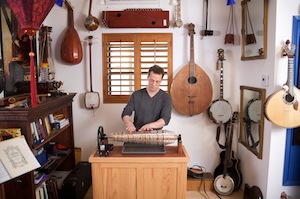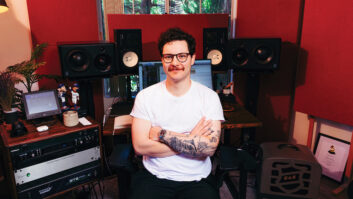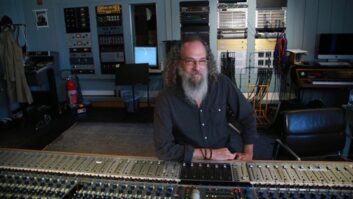
Climbing aboard a used school bus in Queens, N.Y., and driving it 16,000 miles into the heart of South America and back with a friend may seem like a roundabout way to reach Hollywood, but that’s the trip Nathan Barr, currently one of the hot scoring composers on the West Coast, took. Perhaps best known for the sonically complex underscores that beautifully complement the violence and psychological confusion which mark HBO’s wildly successful True Blood series, Barr received a pair of Original Main Title Theme Music Emmy nominations in 2013 (the first composer to be so honored) for his work on FX’s The Americans and the Netflix show Hemlock Grove. He’s currently in the process of expanding the Topanga Canyon project studio where he composes and produces much of his work.
He grew up in the metropolitan New York area, but a business opportunity drew his father to Tokyo when Barr was a child, where he became familiar with musical instruments that lie beyond the scope of Western music. A fascination with unusual color combinations—a human bone trumpet from Tibet, say, paired with a dismantled upright piano—has helped Barr earn a reputation as a composer with a unique sound. When we spoke, he had just finished writing a song with one of rock’s great icons.
How did your collaboration with Pete Townshend come about?
The producers of The Americans reached out to a number of well-known musicians and asked them to consider the idea of writing a song with me that would be featured in the series. Pete responded that he knew my music, liked it, and would be interested.
I sent him stems, about 10 in all, of my ideas, which I recorded in Logic at 24/48 kHz, and Pete imported them into his Pro Tools rig. He wrote lyrics, a wonderful vocal line, and recorded his vocals along with a guitar track. The result, “This Must Be Done,” ended up working beautifully in the show. Pete’s lyrics fit the scene they were ultimately featured in perfectly.
Can you describe your compositional process?
I feel my way into about 90 percent of what I write. Composing is about improvising, I think. I’m constantly looking for new instruments—a rare glass harmonica, or a gourd cello, for example—and I start out by grabbing an instrument that seems appropriate to the scene, or character, I’m working with. When writing on a keyboard or guitar, we all get locked into patterns, places where we want to go. Trying to find a melody on an unusual instrument gets me out of my comfort zone. Musical mishaps occur, which often become interesting.
You studied the cello formally?
That’s right, and I approach everything from the mental space of a cellist, or guitarist, another instrument that I’ve spent a lot of time with. I love to write a melody and dress it up with different backgrounds and textures. That really works well for television. I’ll develop a theme for a character and then vary it by adding something underneath that’s completely different, sonically.
You have to be careful not to go to the well too often, though. If a theme is recognizable to an audience it can become tiresome. I had to watch out for that with the love theme I wrote for the characters of Bill and Sookie on True Blood.

The Americans
Copyright 2014, FX Networks. All rights reserved.
Speaking of True Blood, you often combine string harmonics with overtones produced by unusual instruments…
Right. Cello harmonics, for example, combined with a waterphone, can yield some very powerful, disturbing sounds.
When you returned from your marathon sprint to South America you decided to head west. Did you have a job lined up when you came to L.A.?
In the mid 1990s, I was touring with a group called V.A.S.T., but the performance bug left me, and I decided to apply for a job—any kind of job in the industry—on the West Coast. I submitted a resume to a company called Addis-Wechsler on a Friday, and the following Monday was on my way to L.A. to enter their trainee program. I was running packages, making coffee and reading bad scripts.
Then I left on that trip to South America. My friend—who was born in Brazil—and I spent four-and-a-half months on the road. I learned how enormous the world is and yet how wonderfully accessible and helpful people can be. Years later I found out that one of the reasons Hans Zimmer hired me was because I took that trip!
What was working with Hans Zimmer like?
Hans is a really incredible guy, and he’s extremely powerful in the Hollywood film world. He gave me a crash course in the life of a composer, and technology—I didn’t even know what MIDI stood for back in 1997! I asked him, as a 24-year-old, if he’d be willing to take me along on some industry meetings. Before I knew it, I was having ice cream with Hans and Jeffrey Katzenberg.
Hans is a brilliant businessman. The way he expanded his studio operation to include young composers—a ton of them over the years—has helped all of us enormously. Watch what he does with his new venture, Bleeding Fingers.
You’re in the process of upgrading your studio. Can you tell us about the equipment you rely on?
I have a main studio rig and a second studio. Logic Pro 9 is my sequencer in both, but I also operate a Pro Tools 9 system in my main room. I execute some of my own mixes, but my wonderful assistant, Steve Lukach, does a lot of mixing for me.
A Mac Mini is dedicated to video playback. We mix out of the box, and the Mackie Big Knob desktop monitor system frees us from using the mouse all of the time. I’m a big fan of the Dangerous 2-Bus Summing Mixer. The studio equipment list also includes Apogee AD-16X and DA-16X D-to-A converters, a JL Cooper FaderMaster Professional, Millennia HV-3D preamp and Quested studio monitors.
Although my preference is to record live instruments, and I have a Neumann KM 184 that I like a lot, I do have a number of the common Kontakt-based libraries, Spectrasonics’ Omnisphere and RMX Stylus, and Rob Papen’s Predator. We use Altiverb 6, the Waves Bundle, and IK Multimedia T-Racks when mixing. Project files are automatically synced between the two studios using Dropbox.
What’s going on with the new studio?
My current studio is in a converted garage. The new one will include a live room capable of accommodating up to 35 players. I bought a 1,500-pipe theater organ that had been disassembled for 20 years, and it will have a featured spot in the studio. This Wurlitzer organ was built in 1928, one of three built for Hollywood studios and the only one still surviving. It’s been used to record scores by Bernard Herrmann, Jerry Goldsmith, and John Williams, among others, and was used on the Sound of Music sessions. I’m working with Jay Kaufman, an acoustical engineer and designer, and the architect William Hefner. We expect to be up and running in 2015.
Will you invite us up for a tour when the studio is complete?
Absolutely!







